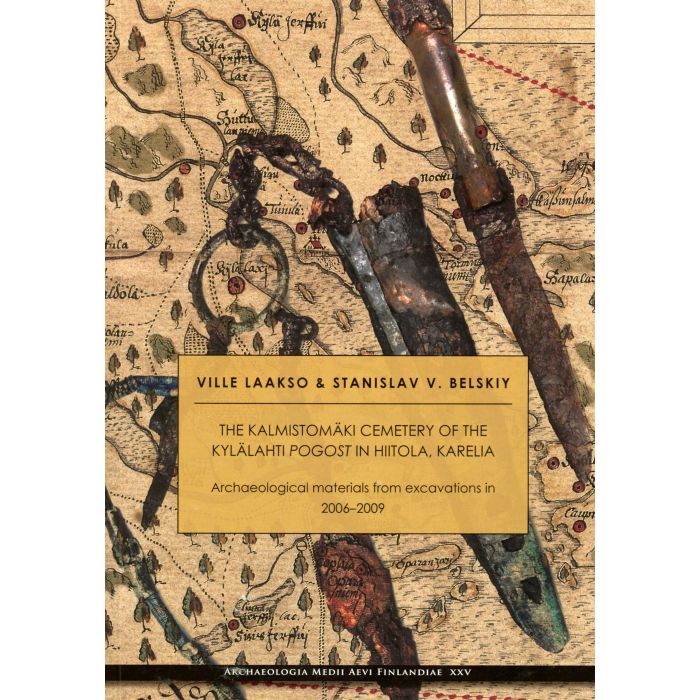Käytämme evästeitä parantaaksemme käyttäjäkokemustasi. Noudattaaksemme uutta sähköisen viestinnän yksityisyysdirektiiviä, meidän täytyy pyytää sinulta lupaa evästeiden asettamiseen. Lue lisää.
The Kalmistomäki Cemetery of The Kylälahti Pogost in Hiitola, Karelia
30,00 €
Varastossa
SKU
978-952-69004-1-4
Laakso, Ville & Belskiy, Stanislav V.
The Kalmistomäki Cemetery of The Kylälahti Pogost in Hiitola, Karelia. Archaeological materials from excavations in 2006-2009
Suomen keskiajan arkeologian seura - Sällskapet för medeltidsarkeologi i Finland
Archaeologia Medii Aevi Finlandiae XXV
s.l. s.a., 328 pp.
The Kalmistomäki Cemetery of The Kylälahti Pogost in Hiitola, Karelia. Archaeological materials from excavations in 2006-2009
Suomen keskiajan arkeologian seura - Sällskapet för medeltidsarkeologi i Finland
Archaeologia Medii Aevi Finlandiae XXV
s.l. s.a., 328 pp.
This book is devoted to the publication of materials obtained during archaeological excavations of the burial ground of Kalmistomäki in Kylälahti in the north-western Ladoga region in 2006–2009. The site may be described as a cemetery attached to a Karelian pogost centre at the north-western periphery of the medieval Novgorod Land. It was used by a population that was obviously very wealthy and had lively contacts with outside areas in different directions.
During the four seasons of archaeological fieldwork carried out in Kylälahti,93 burials were excavated. In 51 cases, diverse artefacts were found accompanying the burials: personal ornaments and costume parts. The cemetery is not only the largest in Karelia in terms of number of burials excavated, but also the richest in terms of number of burials with artefacts.
The site under study is also exceptional in other ways than quantitative measures. For the first time in the archaeology of Karelia, materials of the 14th and 15th centuries are so distinctly represented that they allow us to reach to several highly significant conclusions concerning the evolution of burial rites in the region.
A distinctive feature of the materials from the cemetery of Kylälahti is manifested in finds of Central or Northern European imports. Their presence among the Karelian complexes indicates the continuation of stable tendencies in material culture that had appeared in a more ancient period, as well as the direction of external connections.
The finds suggest that the peculiar material culture of Crusade Period Karelia was not in the least abandoned in the early 14th century. The evidence obtained at the cemetery allows us to distinguish yet another period in the existence of the distinctive material culture of the area from the 14th to the 15th century.
During the four seasons of archaeological fieldwork carried out in Kylälahti,93 burials were excavated. In 51 cases, diverse artefacts were found accompanying the burials: personal ornaments and costume parts. The cemetery is not only the largest in Karelia in terms of number of burials excavated, but also the richest in terms of number of burials with artefacts.
The site under study is also exceptional in other ways than quantitative measures. For the first time in the archaeology of Karelia, materials of the 14th and 15th centuries are so distinctly represented that they allow us to reach to several highly significant conclusions concerning the evolution of burial rites in the region.
A distinctive feature of the materials from the cemetery of Kylälahti is manifested in finds of Central or Northern European imports. Their presence among the Karelian complexes indicates the continuation of stable tendencies in material culture that had appeared in a more ancient period, as well as the direction of external connections.
The finds suggest that the peculiar material culture of Crusade Period Karelia was not in the least abandoned in the early 14th century. The evidence obtained at the cemetery allows us to distinguish yet another period in the existence of the distinctive material culture of the area from the 14th to the 15th century.
| ISBN | 978-952-69004-1-4 |
|---|---|
| ISSN | 1236-5882 |
| Kustantaja | Suomen keskiajan arkeologian seura - Sällskapet för medeltidsarkeologi i Finland |
| Sarja | Archaeologia Medii Aevi Finlandiae |
| Painovuosi | s.a. |
| Julkaisun kansi | Pehmeäkantinen |
| Sidontatapa | Nidottu |
| Kielet | englanti |
| Tieteenalat | Arkeologia |


